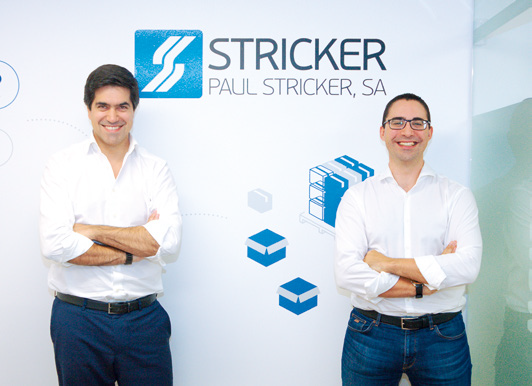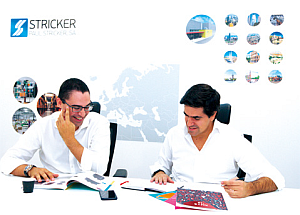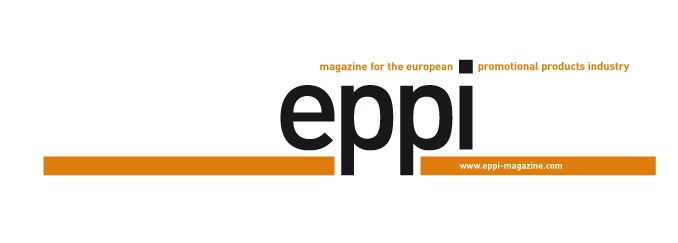Paul Stricker is expanding: Taking over the Czech rival Reda in June 2018 enabled the import company which is headquartered in Coimbra, Portugal to hugely extend its presence in Europe and strengthen its distribution network with a logistics hub in the heart of the Continent. CEO Paulo Stricker and CFO Alexandre Gil on the market developments, the group’s strategic alignment and their plans for the integration of Reda.

Paulo Stricker (l) and Alexandre Gil.
The promotional products market is on the move, so is the import business. Which developments have there been at Paul Stricker over the past years?
Paulo Stricker: Our Brazilian subsidiary has developed into a well-established company since it was founded in the year 2014 and is soon to be the market leader in Brazil. Furthermore, we have extended our presence in the direction of the Middle East, North Africa and the ex-USSR. Nevertheless, the backbone of our operation is and will continue to be the European markets.
Alexandre Gil: We have also invested heavily in digital tools, in order to improve the customer support and user experience. For example, now it is possible to automatically vectorize the logos for the printed orders online. We have also invested strongly in tailor-made web connector structures, enabling direct links with the websites of our clients and speeding up the order submission process.
Paulo Stricker: Perhaps the most significant development of the past years was, however, taking over Reda earlier this year in June – which was our first acquisition. As a result, our headcount in Europe has increased from around 350 people up to more than 600, which means in one stroke we have become one of the leading players in most of the European countries. Whereas the turnover of Paul Stricker was approx. 50 mil. Euros before the take-over, in 2018 we are expecting a total turnover for the Group of over 85 mil. Euros.
You have taken over 100% of the Reda shares. What made you decide to take this step?
Alexandre Gil: First of all, there was the possibility of acquiring the company. There are perhaps 30 promotional product importers in Northern Europe with a turnover of 20 mil. Euros or more, and when the opportunity arises to buy a competitor, one should always check the advantages it could bring with it. In the course of the extensive due diligence, we established that there were few overlaps between the product ranges of Reda and Paul Stricker and thus the risk of them cannibalising each other was pretty low. In this way, we are extending our line-up to include a host of attractive products that are well-established on the market. However the decisive issue was that by taking over Reda we could establish a location in the centre of Europe. Fast delivery times are of high significance in our market segment and are becoming more and more crucial for surviving on the competitive market. As a Portuguese company we are located in a “corner” of Europe and had been asking ourselves for years how we could guarantee fast delivery throughout the Continent in the future, especially since we have been recording particularly strong growth in Central Europe. Purchasing Reda was thus a huge opportunity for us.
Paulo Stricker: The logistics and production centre of Reda in Brno in the Czech Republic is, in geographical terms, a very good enhancement to the Stricker hub in Portugal. We are now in a position to guarantee a fast and efficient supply chain throughout Europe, from West to East and from North to South. The take-over also helps us scale our business instead of continuing to grow in the classic organic way. Scale increase becomes more and more important for suppliers like ourselves.
How are these two entities going to coexist?
Paulo Stricker: We will continue to operate two independent companies, working with both catalogues, each will be supplied by the respective logistics and production centre and managed by the respective back-offices in Portugal and the Czech Republic. The main difference is that a single field sales team will be pushing for both catalogues on the market and we will harmonize the service levels and policies pushing for the best in each company. In this way, we can increase the offer and service possibilities for our full client base and we are already receiving very positive feedback from the market. Each catalogue contains around 1,000 products, of which around 150 to 200 are comparable. Furthermore, the two product ranges enhance each other very well. Reda’s Excursion catalogue is for instance stronger in the umbrella and ceramic segments, whereas Stricker’s hi!dea catalogue is stronger in the bag and office segments.
Alexandre Gil: The commercial development will be integrated into a single leadership and strategy but both catalogues will coexist, which is possible due to low product overlap. Obviously, there are possibilities of further integration levels, but this should be analysed with caution after some actual market experience with this new model of operation. The last thing we want is to destroy value for us and our clients in the process. The most immediate implication of the simultaneous management of two catalogues was the need to significantly reinforce our sales team. During the last few months we have brought to our Group a significant number of very experienced people that will assure us the best possible customer support and market development. We are immensely proud of the amazing team we have now.
How will the logistics at the two locations in Coimbra and Brno be organised – which projects will be undertaken by which unit?
Alexandre Gil: In the first year we will handle the orders for the Reda line-up in Brno and will process orders for the Stricker product range in Coimbra, but of course we are planning a gradual integration in order to be able to process orders as efficiently as possible in the future. That means for example goods will be supplied to customers from Northern, Central or Eastern Europe by Brno and Portugal will deliver goods to Portugal, Spain, France, Italy and the UK. To realise all of this within one year is a huge project – especially in terms of the digital infrastructure. The human and capital factors are also a challenge, but the IT integration is a bigger one.
How will the sourcing in the Far East be regulated in future?
Alexandre Gil: All sourcing activities will be centralized at the Stricker office in Shanghai. The sourcing team of Reda has already been completely integrated into this structure.
What will happen with the remaining Reda employees?
Alexandre Gil: The big message here is there will be no downsizing. We have plans for growth and the idea is indeed to expand our capabilities and structure in Brno. Obviously, some redundancies were identified and, in those cases, we tried to reallocate the people to new functions – in a business so specific as ours, experience is a very valuable asset. The sales team endured the biggest adjustment as we need to integrate it within Stricker’s team and that process is already completed.
How long do you think the integration of Reda will take?
Alexandre Gil: We estimate it will take around two years until the integration and operation fine tuning is complete. It isn’t just about the systems, the stocks etc., but also, and specially, about the people and the corporate culture that are key to success. In the last months, there has been heavy travelling both ways between Portugal and Czech Republic as it is essential that the joint goals are clearly formulated and that everyone pulls in the same direction. This requires a clear communication but also a lively dialogue.
Which short-term growth predictions do you have for your new location?
Alexandre Gil: We are expecting Reda to achieve a 25% growth rate in 2019. And, given our track record, I believe this is a conservative target.
 How do you see the entire market presently and what are the main trends one should expect in the close future?
How do you see the entire market presently and what are the main trends one should expect in the close future?
Paulo Stricker: We feel the market is positive and growing. New concepts of distribution are being created – mainly online – and these are opening up new segments of the market that were little explored before. This has also been a growth driver and I believe this will be the case even more so in the future. The demands in the suppliers are increasing hand in hand with this market development: The service has to improve and become faster. In a few years, delivery times of between 24 and 48 hours will no longer be deemed as express but as standard, at the same time the tolerance for errors will decrease even more. There will be demand for even further individualisation and responsive and more user-friendly communication tools and finally the demand for small and tiny volumes will increase further, pushed by the online distributors.
Alexandre Gil: The digital transformation within our industry is a topic of great discussion, which I view positively, since the digitalisation leads to much higher efficiency. I believe there is a long road ahead of us in this field, but we should not expect levels of automatization that we see in certain other industries: the extension of products we trade and printing possibilities are continuously opening new combinations that are impossible to convert into automatic standards at the distance of three clicks. The balance between offering the maximum choice and assuring the minimum time consumption in the fulfilment process is one of the biggest challenges ahead of us and makes me believe there will continue to be scope for many types of business models in our industry.
Do you think we will experience further fusions among the import companies in the near future?
Paulo Stricker: There are relevant pros and cons that should be carefully considered in an M&A process. Scale is important but also smaller companies can adapt and evolve faster than larger corporations, which is also a critical factor in today’s fast-paced changing world.
What are the main plans for the future of the organisation?
Alexandre Gil: First of all, guaranteeing the full integration of Reda into the Stricker culture. And at the same time, we must assure our organic growth doesn’t slow down – we have been growing by more than 40% each year since 2014. To make sure our growth is sustainable we will continue to improve our service levels and collection. For example, today our standard printing time is 48 hours and we aim to further improve. Most importantly, we want to continue to be seen as a fast and flexible company that knows the client by his name and is able to provide effective solutions in real time. Our growth can’t be an excuse to reduce the level of excellence and standards to our client.
Paulo Stricker: Growth is in our DNA, so we will stay on our path, always finding new ways to achieve it. New geographies, better service and stock levels, innovative concepts and products…: You can always expect a new and important step from us every year. The next steps are already planned and being prepared, but we like surprises, so please wait and see.
// Till Barth spoke with Paulo Stricker and Alexandre Gil.
photos: Paul Stricker



